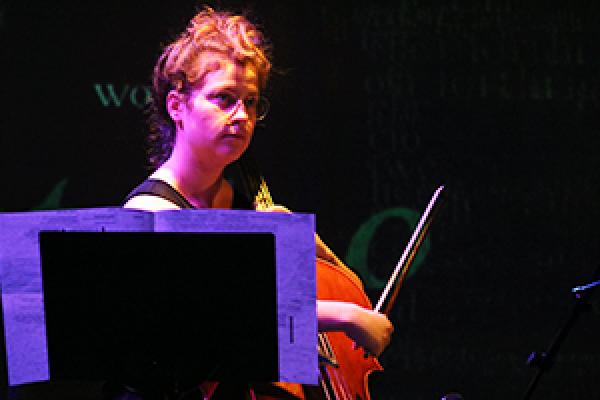School of Music PhD uses ACCAD Motion Lab to study performers' movement

How does a musician’s expressive movement influence how an audience perceives their performance?
Caitlyn Trevor, a graduate teaching associate in the School of Music, used the Advanced Computing Center for the Arts and Design (ACCAD) to find out.
After graduating with her BA in music from Illinois Wesleyan University, Trevor came to Ohio State to study under Distinguished Professor of Arts and Humanities David Huron and the Cognitive Systematic Musicology Laboratory, which is housed within the School of Music. She wanted to study music cognition — the psychology and behaviors behind how people create and observe music.
“I’m very interested in the ways performers think and the ways performers are perceived,” said Trevor, a cellist who received her MA in music theory in 2016 before earning her master of music in cello performance last August. “I noticed when I play, if I move a lot, my friends who don’t play tend to think that it was a really good performance.”
Trevor theorized that audiences favor performances in which the musician demonstrates expressive movements. Over the summer, with help from ACCAD animation and motion capture specialist Vita Berezina-Blackburn, ACCAD alumnus Lakshika Udakandage (MFA, 2017, digital animation and interactive media), and a summer graduate research grant from the Center for Cognitive and Brain Sciences, Trevor put her hypothesis to the test. She brought four musicians into ACCAD’s Motion Lab, where markers were placed on various parts of their bodies to capture their movements as they played.
Afterward, Trevor took the motion-capture data and used a software called MotionBuilder to create three animations out of each musician's performance: one that showed the musicians’ original motion, one portraying diminished motion and the third showing exaggerated motion. With the help of ACCAD alumnus John Luna (MFA, 2017, dance), she merged the three animations into one video with the music overlaid over it. The video had a slider enabling users to manipulate the video to show more or less motion from the performer. Participants of the study were asked to create the best performance by adjusting the musicians’ movement.
“Our results showed that people prefer to adjust to more motion when they’re trying to make a better performance overall,” Trevor said.
.dailypost {background-color:#000; padding:30px;color:#fff;font-family:"capita";font-size: 1.25em;font-weight: 400;} .clicktotweet {float: right; text-align:right;}
New @OhioStateMusic research shows how the motion of a musician impacts his/her audience. #ASCDaily
Trevor’s research will soon be published in the peer-reviewed journal, Music Theory Online. She hopes it will demonstrate the ability for others in the music cognition world to use games and motion capture as research tools. She also hopes her research will encourage musicians to incorporate more expressive movement into their pieces — whether it be for auditions or performances.
“Musicians are aware of how motion is a part of their performance, but I don’t know if they know how much motion is affecting the overall impression of it,” Trevor said.
Trevor recently finished her PhD and will soon head to London to work as a postdoctoral research assistant with music cognition researcher Elaine Chew at the Music, Performance and Expressivity Laboratory at Queen Mary University. She plans to study how musicians make decisions about musical structures during performances, a topic Trevor covered extensively in her dissertation.
“When classical musicians play, even though they’re looking at a score, the score is abstract,” she said. “It’s sort of like a script for an actor; there’s still a lot of decisions you have to make as a performer, and how we make those decisions is not completely understood.”
Trevor is grateful for the time she spent at Ohio State, the freedom she enjoyed while conducting her research and the guidance and assistance she received from the School of Music and ACCAD.
“ACCAD is a huge part of everything I’ve done here,” Trevor said. “They’re so open and excited and encouraging of you to use your passions, and that’s really important to me.”
